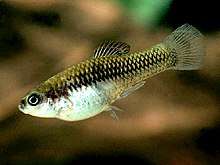Monterrey platyfish
The Monterrey platyfish (Xiphophorus couchianus) is a species of freshwater fish in family Poecilidae. A live-bearer, it was native to a very small section of the San Juan River system (itself part of the Rio Grande basin) in the vicinity of the city of Monterrey, Mexico.[2][3] The specific name refers to the American soldier and naturalist Darius N. Couch (1822-1897) who collected the type on a self financed expedition to Mexico.[4]
| Monterrey platyfish | |
|---|---|
 | |
| Scientific classification | |
| Kingdom: | Animalia |
| Phylum: | Chordata |
| Class: | Actinopterygii |
| Order: | Cyprinodontiformes |
| Family: | Poeciliidae |
| Genus: | Xiphophorus |
| Species: | X. couchianus |
| Binomial name | |
| Xiphophorus couchianus (Girard, 1859) | |
| Synonyms[2] | |
| |
Appearance
The Monterrey platyfish is a dull-colored fish, appearing not unlike a female guppy. Another form, sometimes referred to as X. aff. couchianus, was discovered in Apodaca, central Monterrey, in 1983. It has large black blotching, unlike the typical, unspotted form from the Huasteca Canyon. Whether the Apodaca form represents a separate species is presently unclear.[3][5][6]
Sexual dimorphism is moderate, the male Monterrey platyfish growing to a maximum overall length of 4 cm (1.6 in) and the female 6 cm (2.4 in).[2]
Conservation
IUCN lists the Monterrey platyfish as "extinct in the wild".[1] Although once found more widely in the region of Monterrey, populations have been lost to urban sprawl, with water habitats either drying up (due to land reclamation and water extraction) or being heavily polluted. Introduced species is another threat. "Safety" population are maintained in captivity, mainly by the Centro de Resguardo para Peces en Peligro de Extinción (at Universidad Autónoma de Nuevo León in Mexico, maintaining both the typical form and X. aff. couchianus) and Xiphophorus Genetic Stock Center (at Texas State University, maintaining typical form), and via the American Livebearer Association (mostly private aquarists in the United States, maintaining typical form).[3][5] The species has proven harder to maintain in captivity than most Xiphophorus species.[5]
The Monterrey platyfish shared the title as northernmost naturally distributed Xiphophorus with the closely related northern platyfish (X. gordoni) and marbled swordtail (X. meyeri), which are two species that also are restricted to small parts of the Rio Grande basin and seriously threatened.[3][7]
References
- Almada-Villela, P. & Contreras-Balderas, S. (2019). "Xiphophorus couchianus". IUCN Red List of Threatened Species. 2019: e.T23156A2784841. doi:10.2305/IUCN.UK.2019-2.RLTS.T23156A2784841.en.
- Froese, Rainer and Pauly, Daniel, eds. (2018). "Xiphophorus couchianus" in FishBase. September 2018 version.
- Ceballos, G.; E.D. Pardo; L.M Estévez; H.E. Pérez, eds. (2016). Los peces dulceacuícolas de México en peligro de extinción. pp. 48, 280. ISBN 978-607-16-4087-1.
- Christopher Scharpf; Kenneth J. Lazara (26 October 2019). "Order CYPRINODONTIFORMES: Families POECILIIDAE, ANABLEPIDAE, VALENCIIDAE, APHANIIDAE and PROCATOPODIDAE". The ETYFish Project Fish Name Etymology Database. Christopher Scharpf and Kenneth J. Lazara. Retrieved 9 November 2019.
- Coletti, T. (December 2007). "Preserving Xiphophorus couchianus in the Home Aquarium, Part I: Sad History & Unanswered Questions". tfhmagazine.com. Retrieved 23 September 2018.
- Kallman, K.D.; S. Kazianis (2006). "The genus Xiphophorus in Mexico and Central America". Zebrafish. 3 (3): 271–285. doi:10.1089/zeb.2006.3.271.
- Kang, J.H.; M. Schartl; R.B. Walter; A. Meyer (2013). "Comprehensive phylogenetic analysis of all species of swordtails and platies (Pisces: Genus Xiphophorus) uncovers a hybrid origin of a swordtail fish, Xiphophorus monticolus, and demonstrates that the sexually selected sword originated in the ancestral lineage of the genus, but was lost again secondarily". BMC Evolutionary Biology. 13 (25): 25. doi:10.1186/1471-2148-13-25. PMC 3585855. PMID 23360326.
- "Xiphophorus couchianus". Integrated Taxonomic Information System. Retrieved 9 December 2004.
